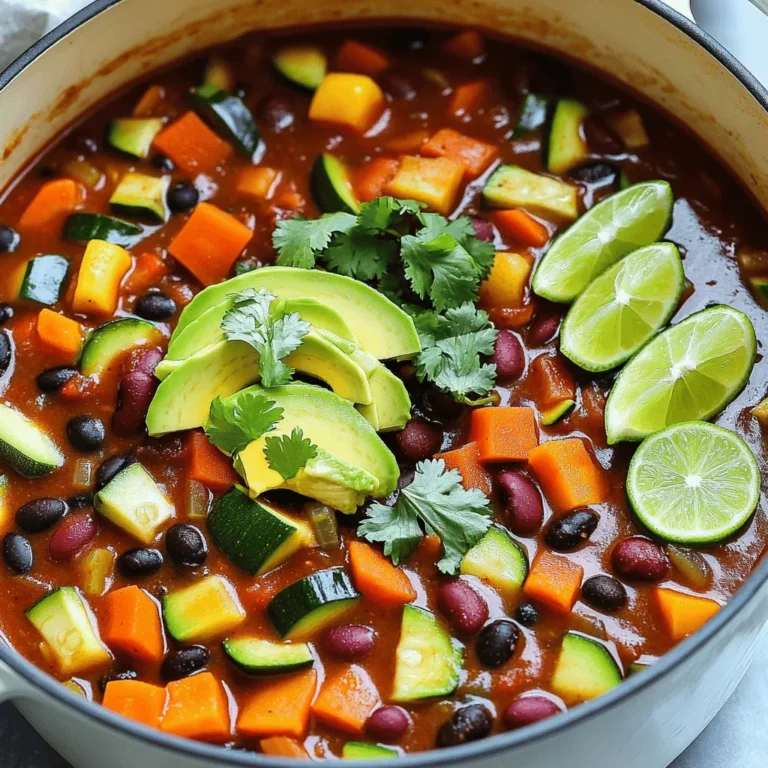Looking for a hearty meal that’s packed with flavor and easy to make? This Vegetarian Chili recipe is your answer! Bursting with wholesome ingredients, from vibrant vegetables to savory spices, it’s perfect for any occasion. Whether you follow a vegetarian diet or simply love a good chili, you’ll find joy in this dish. Join me as we dive into my favorite recipe guide that will excite your taste buds and warm your heart!
Ingredients
Essential Ingredients for Vegetarian Chili
– 1 tablespoon olive oil
– 1 small onion, finely diced
– 2 cloves garlic, minced
– 1 bell pepper (any color), chopped into small pieces
– 1 medium zucchini, diced into bite-sized cubes
– 1 medium carrot, diced into small pieces
– 1 can (15 oz) black beans, drained and rinsed thoroughly
– 1 can (15 oz) kidney beans, drained and rinsed thoroughly
– 1 can (15 oz) diced tomatoes, including all the juice
– 1 cup corn kernels (fresh or frozen)
– 2 tablespoons chili powder
– 1 teaspoon ground cumin
– 1 teaspoon smoked paprika
– ½ teaspoon cayenne pepper (optional, for an extra kick)
– Salt and black pepper to taste
To make a great vegetarian chili, you need some key ingredients. First, olive oil is essential for sautéing. It adds flavor and helps cook the veggies. Next, onion and garlic give the dish a nice base. Their smell makes your kitchen feel warm and inviting.
You can add various vegetables like bell pepper, zucchini, and carrot. They bring color and texture. Beans and tomatoes are the heart of the chili. Black beans and kidney beans add protein. Diced tomatoes provide a rich sauce.
Finally, spices and seasonings are a must. Chili powder, cumin, and smoked paprika create a warm, spicy flavor. If you like it hot, add cayenne pepper. Don’t forget salt and black pepper to taste.
Optional Toppings
– Fresh cilantro
– Slices of avocado
– Lime wedges
Toppings can elevate your chili. Fresh cilantro adds a burst of flavor. It also makes the dish look bright and fresh. Slices of avocado give a creamy touch. They balance the spices well. Lime wedges add a zesty kick. Squeeze some on top for extra taste.
For the full recipe, check out the details above. Enjoy making your vegetarian chili!
Step-by-Step Instructions
Cooking Process Overview
1. Sautéing the aromatics
Start by heating the olive oil in a large pot over medium heat. When the oil shimmers, add the finely diced onion. Sauté for about 5 minutes until the onion is soft and see-through. Next, stir in the minced garlic and cook for one more minute. This step adds a lovely base flavor to your chili.
2. Adding vegetables
Now, add the chopped bell pepper, diced zucchini, and carrot to the pot. Sauté these veggies for about 5 to 7 minutes. You want them to soften and release their flavors. This mix gives your chili a colorful and tasty boost.
3. Mixing in beans and spices
It’s time to add in the star ingredients! Stir in the black beans, kidney beans, diced tomatoes (with juice), and corn kernels. Then, sprinkle in the chili powder, ground cumin, smoked paprika, cayenne pepper (if you like it spicy), and salt and black pepper to taste. Mix everything well so all the flavors combine.
Simmering the Chili
1. Cooking time and heat adjustments
Bring the mixture to a gentle simmer. Once it bubbles, reduce the heat to low. Cover the pot with a lid and let it cook for about 20 to 25 minutes. Stir occasionally. This step helps blend the flavors of your chili and makes it rich.
2. Tips for flavor enhancement
After cooking, taste your chili. You can adjust the seasoning if needed. If you want it thicker, uncover the pot and cook for an extra 5 to 10 minutes while stirring. This gives your chili a hearty texture.
Serving Suggestions
1. Garnishing the dish
Serve your hot chili in bowls. Top it with fresh chopped cilantro and slices of avocado for creaminess. A squeeze of lime juice adds a zesty finish that brightens the dish.
2. Best accompaniments
This chili goes well with warm cornbread, tortilla chips, or a simple green salad. Each bite can be a new experience with these sides!
For the full recipe, check out the Fiery Fiesta Vegetarian Chili details above.
Tips & Tricks
How to Customize Your Chili
You can make this chili fit your taste. For a vegan version, just skip the avocado. Use veggie broth instead of water for more flavor. If you love heat, add more cayenne or a chopped jalapeño. You can also play with spices. Try adding smoked chipotle for a smoky twist or some fresh herbs like oregano for extra flavor.
Cooking Techniques
You can cook your chili on the stovetop or in a slow cooker. For the stovetop, follow the steps in the Full Recipe. It takes about 45 minutes. If you use a slow cooker, just add all the ingredients and cook on low for 6-8 hours. This will give the flavors time to blend deeply.
If you own an Instant Pot, you can make this chili in just 20 minutes. Use the sauté function first for the onions and garlic. Then, add all the other ingredients and set it to pressure cook for 10 minutes.
Enhancing Nutrition
Want to boost nutrition? Add some chopped kale or spinach. These greens blend well and add vitamins. You could also stir in some quinoa for extra protein and fiber.
Instead of regular olive oil, try using avocado oil. It has a higher smoke point and adds healthy fats. Swap out regular beans for lentils for a different texture. Just remember, lentils cook faster than beans, so adjust your cooking time.
These tips will help make your vegetarian chili even better!

Variations
Different Styles of Vegetarian Chili
You can make vegetarian chili in many ways. One popular style adds a smoky flavor. You can get this by using smoked paprika or chipotle peppers. These ingredients bring warmth and depth to your dish.
If you want something different, try a beanless chili. Instead of beans, use lentils or quinoa. These ingredients provide protein and texture. They also soak up the spices well.
Seasonal Ingredient Ideas
Using fresh, seasonal veggies can make your chili taste better. In spring, add asparagus or peas. During summer, use tomatoes and bell peppers. Fall brings squash and sweet potatoes, while winter is great for root veggies like carrots and turnips.
You can also use leftovers in your chili. Got extra veggies from dinner? Toss them in! This not only reduces waste but also adds flavor.
Global Influences
Adding spices from different cultures can elevate your chili. Try using cumin, coriander, or even curry powder for a twist. Each spice brings a unique taste, making your chili more exciting.
You might also enjoy fusion recipes. Think about blending chili with Asian flavors, like ginger and soy sauce. These combinations can surprise your taste buds in a delightful way.
For a complete experience, check out the Full Recipe for delicious vegetarian chili ideas!
Storage Info
How to Properly Store Vegetarian Chili
To keep your vegetarian chili fresh, start by cooling it down. Once cool, transfer it to an airtight container. If you plan to eat it within three to four days, refrigerate it. For longer storage, use your freezer. Portion the chili into freezer-safe containers. This way, you can thaw just what you need later.
Reheating Instructions
When you’re ready to enjoy leftovers, there are a few great methods. The best way is to heat it on the stove. Pour the chili into a pot and warm it over medium heat. Stir occasionally to prevent sticking. This keeps the flavor rich. You can also use a microwave for quick reheating. Just place it in a microwave-safe bowl, cover it, and heat for one to two minutes. Stir halfway through to ensure even heating.
Shelf Life and Signs of Spoilage
Chili lasts in the fridge for about three to four days. In the freezer, it can stay good for up to six months. Always check for signs of spoilage before eating. If it smells sour or has an off color, it’s best to toss it. If you see mold, throw it away too. Storing chili properly helps you enjoy this hearty dish longer!
FAQs
Is Vegetarian Chili good for meal prep?
Yes, vegetarian chili is great for meal prep. It stores well in the fridge and freezer. You can make a big batch and keep it for later. This saves time on busy days. The flavors also get better after sitting. You can reheat it easily in the microwave or on the stove. Plus, it’s healthy and filling, making it a smart choice for any meal plan.
Can I add meat to this recipe?
Yes, you can add meat if you want. Ground beef or turkey works well. Just cook the meat first before adding the other ingredients. Make sure to drain any fat. This keeps the chili rich and hearty. You can also use cooked chicken or sausage. Adjust the spices to match the meat’s flavor.
What can I use instead of beans?
If you want to skip the beans, there are good alternatives. You can use lentils, which add protein and fiber. Chopped mushrooms also work well, giving a meaty texture. You can try quinoa for a grainy feel. Other options include diced tofu or tempeh for more protein. These substitutes keep your chili filling and tasty.
How spicy is this chili?
The spice level is flexible. The chili powder gives it warmth. If you want more heat, add cayenne pepper. You can also use jalapeños for a fresh kick. Taste as you cook and adjust the spices. For milder chili, just use less chili powder. It’s all about what you like!
In this post, I covered how to make delicious vegetarian chili. We explored key ingredients, cooking steps, and tips for customization. You learned about different styles and how to store your chili safely. Remember, you can adapt this recipe to suit your taste. Try adding your favorite spices or seasonal veggies. The options are endless! Enjoy experimenting, and don’t hesitate to make this chili your own. You’ll love the flavors and feel proud of your dish. Happy cooking!


